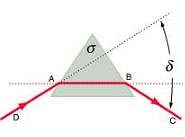Test: Refraction & Dispersion By Prism - NEET MCQ
10 Questions MCQ Test Physics Class 12 - Test: Refraction & Dispersion By Prism
A mark on the bottom of the liquid appears to rise by 0.1 m. The depth of the liquid is 1 m. The refractive index of the liquid is
| 1 Crore+ students have signed up on EduRev. Have you? Download the App |
Which is the position of minimum deviation in prism?
The ratio of angular dispersion of to the angle of deviation for the mean wavelength is called Dispersive Power. Represented by
Which relation do we use to find the refractive index of material of prism
A prism of refractive index √2 and refractive angle A produces minimum deviation δm of a ray on one face at an angle of incidence 45°. The values of A and δm are respectively
A thin prism P1 with angle 4° and made from glass of refractive index 1.54 is combined with another thin prism P2 made from glass of refractive index 1.72 to produce dispersion without deviation . The angle of prism P2 is:
|
98 videos|387 docs|104 tests
|



















